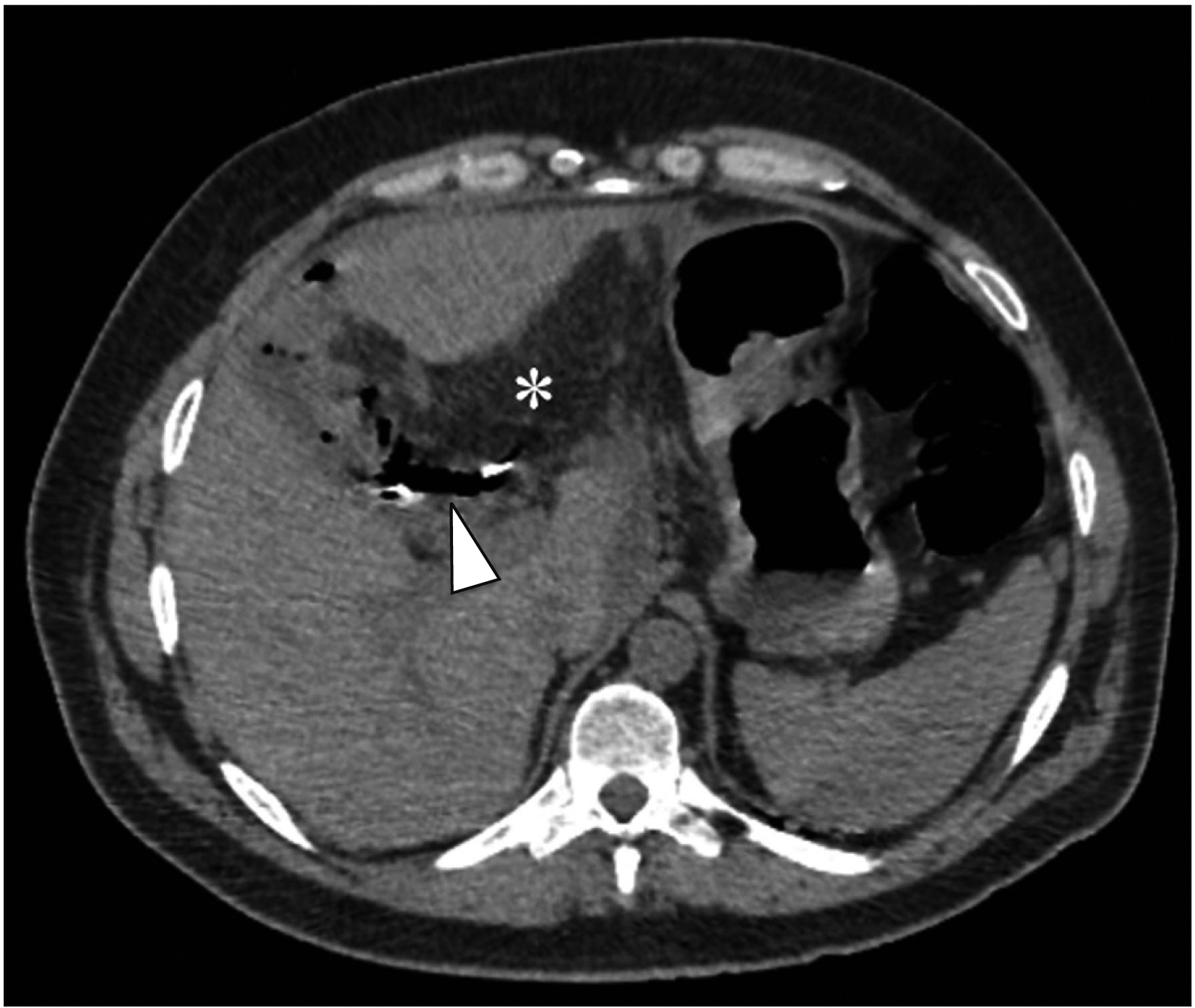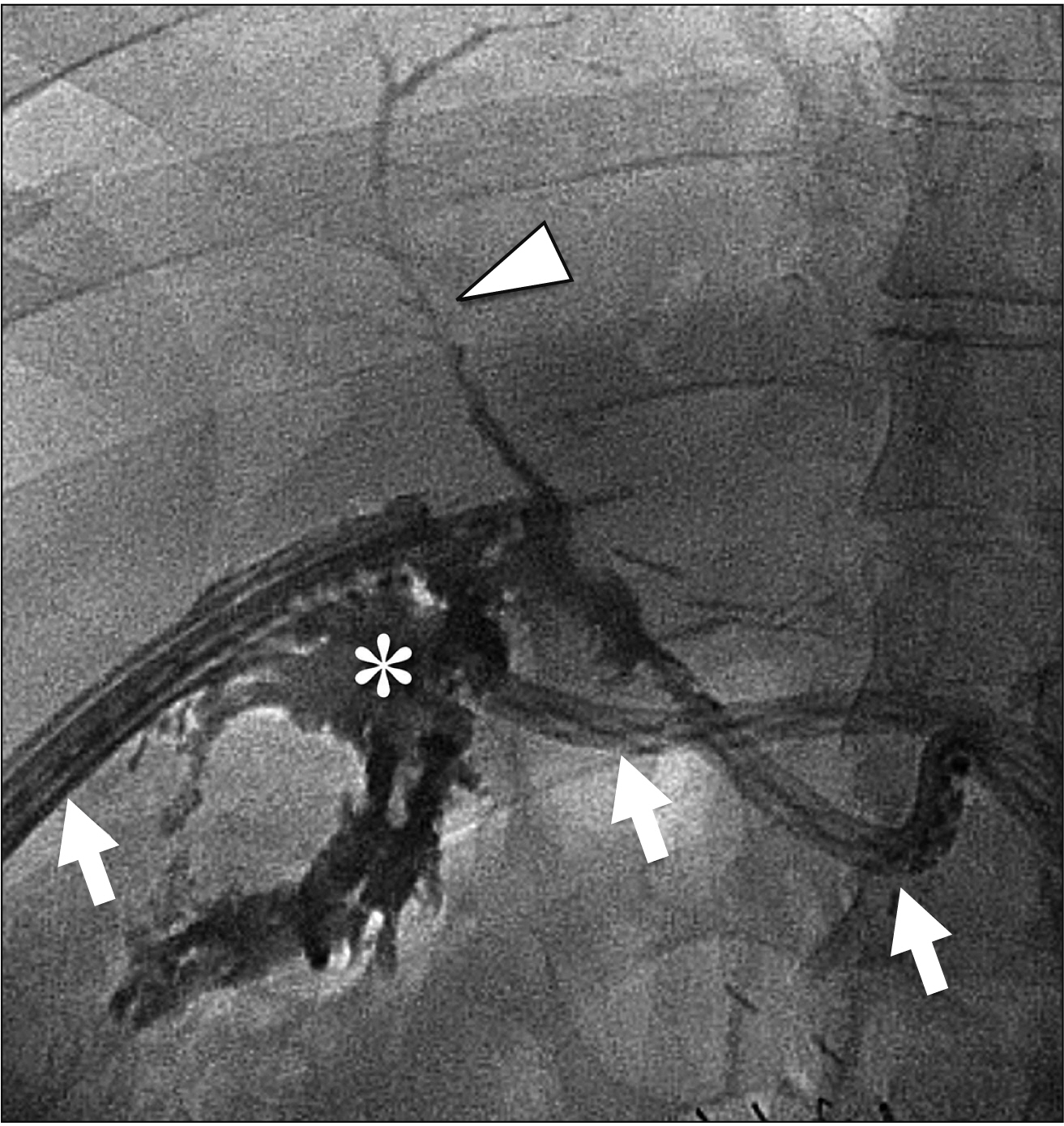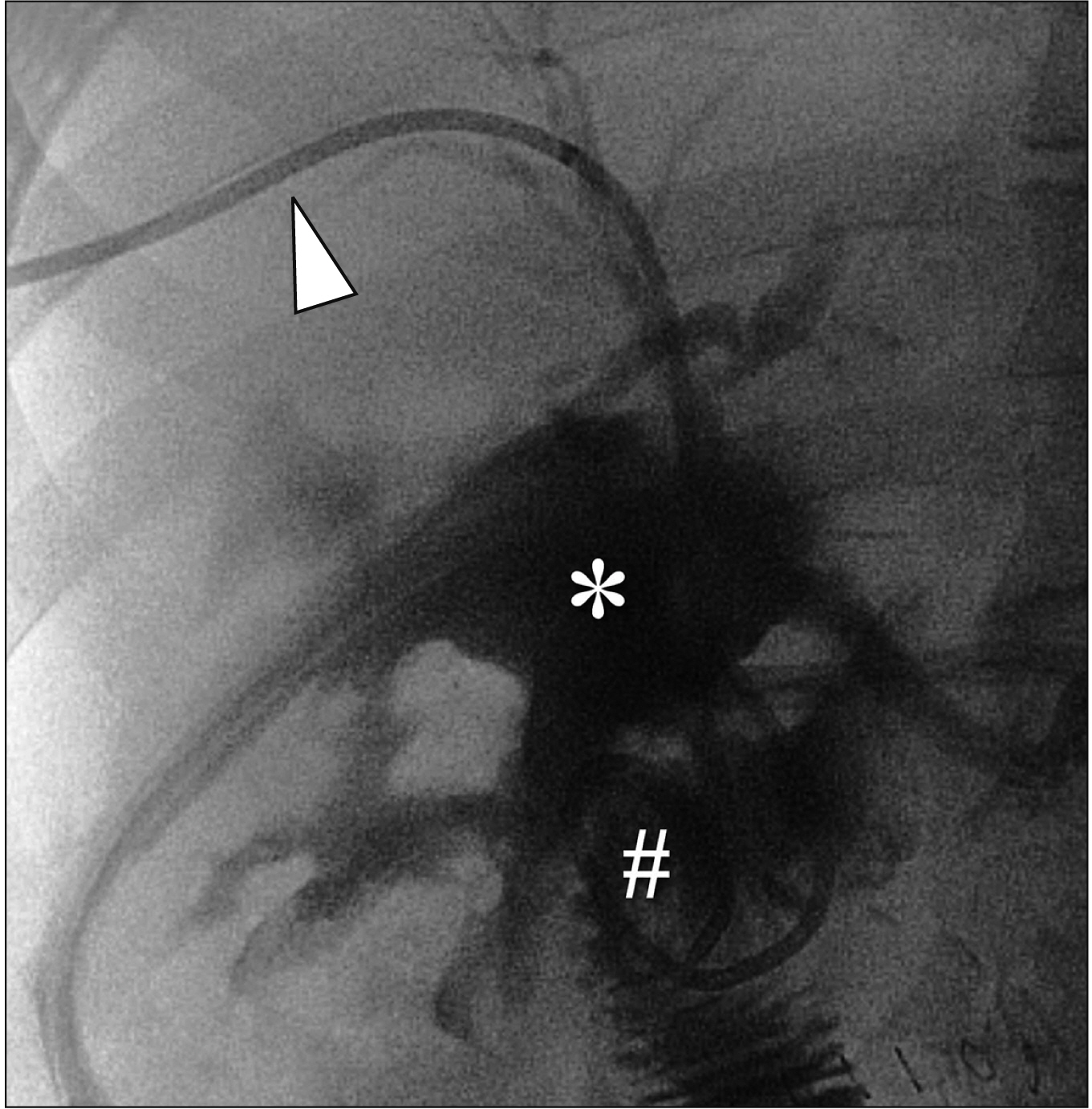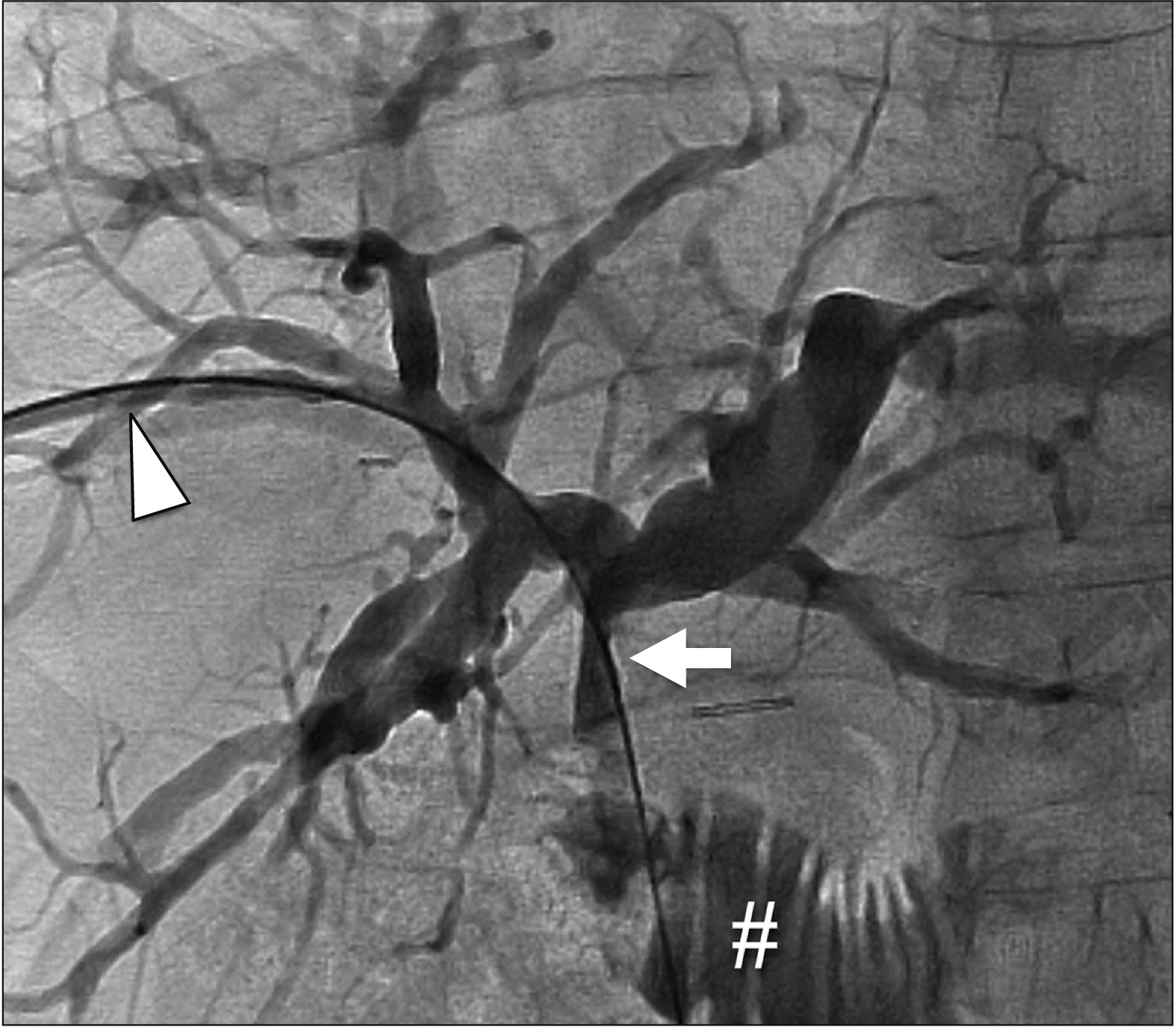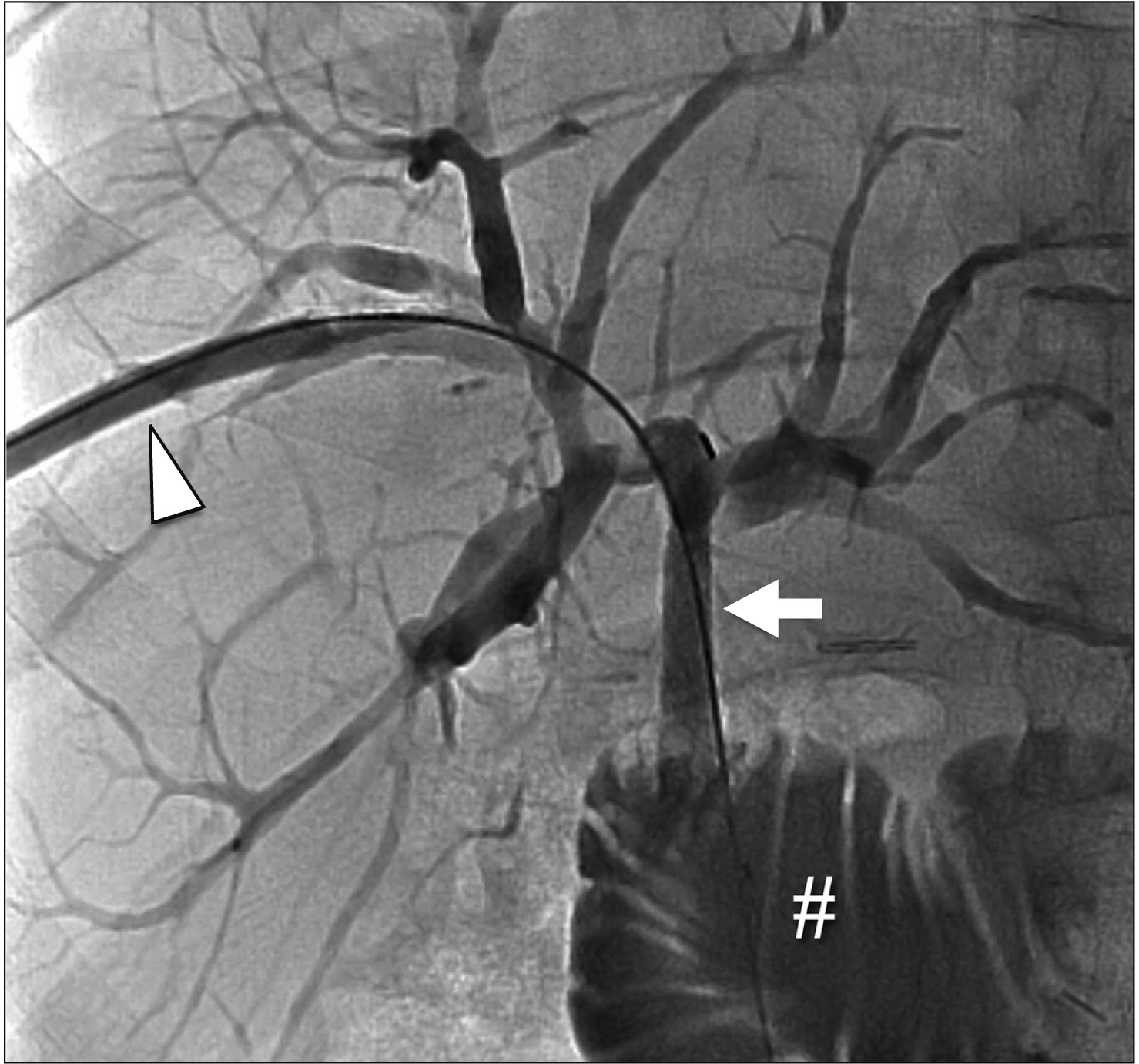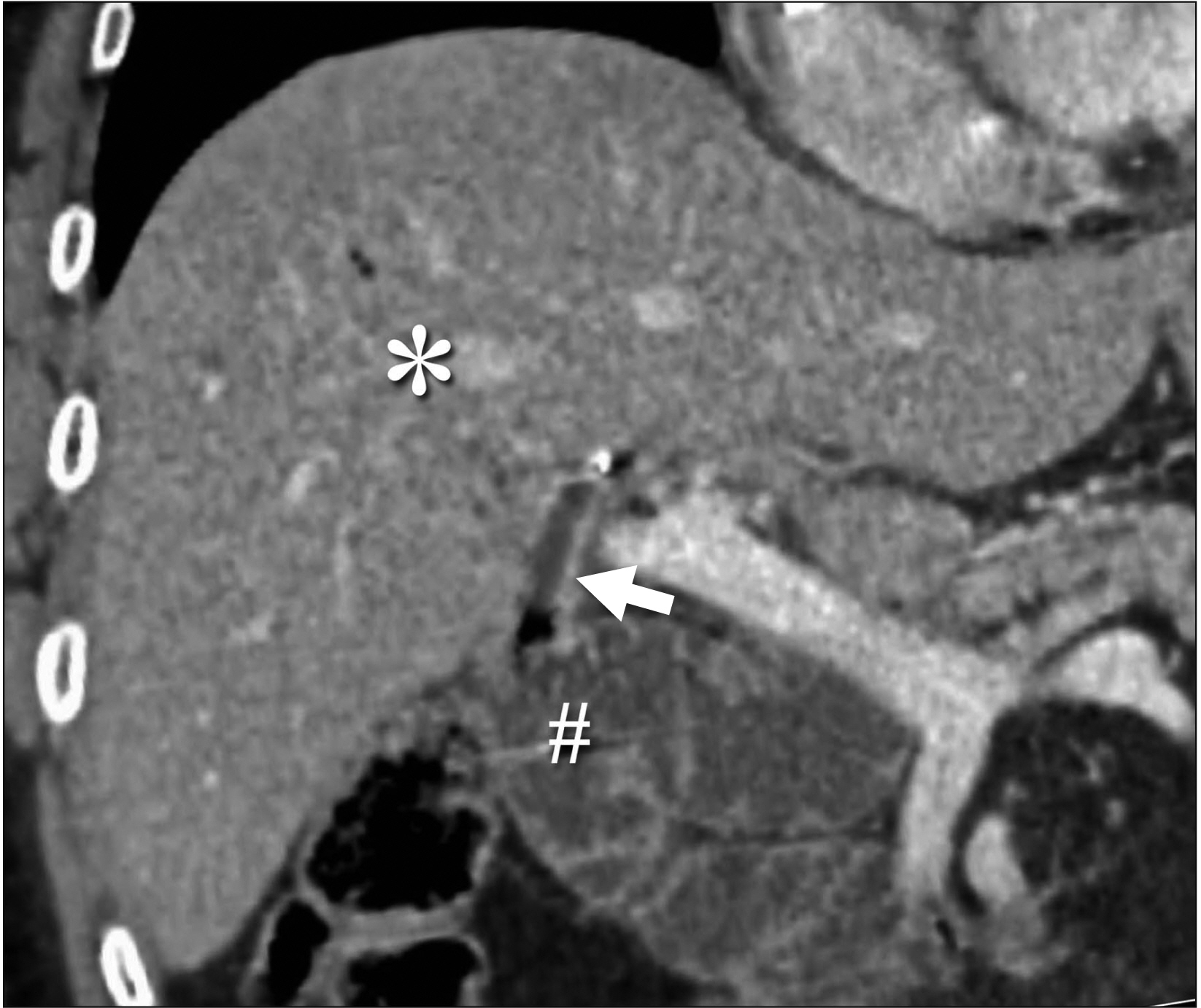Ann Hepatobiliary Pancreat Surg.
2021 Aug;25(3):386-389. 10.14701/ahbps.2021.25.3.386.
Percutaneous trans-hepatic rescue and neo-creation of a post-surgical complete hepaticojejunostomy dehiscence
- Affiliations
-
- 1Department of Diagnostic Imaging, Interventional Radiology Unit, E.O. Galliera Hospital, Genova, Italy
- 2Department of Medical Area, Medical Oncology Unit, E.O. Galliera Hospital, Genova, Italy
- 3Department of Diagnostic Imaging, Radiology Unit, E.O. Galliera Hospital, Genova, Italy
- 4Department of Abdominal Surgery, General and Hepato-Bilio-Pancreatic Surgery Unit, E.O. Galliera Hospital, Genova, Italy
- KMID: 2519296
- DOI: http://doi.org/10.14701/ahbps.2021.25.3.386
Abstract
- Biliary leakage complicating hepaticojejunostomy is a therapeutic dilemma for surgeons, gastroenterologist, and interventional radiologist. It is a major cause of postoperative morbidity. Percutaneous biliary intervention techniques have been developed for treating benign post-surgical biliary disease in patients not having severely compromised clinical conditions. Interventional radiology manoeuvres are especially indicated as the first line of treatment if endoscopic procedures are unfeasible for patients due to postsurgical anatomical modifications. We present a case of post-surgical complete hepaticojejunostomy dehiscence that was treated totally by percutaneous techniques with trans-hepatic rescue and hepaticojejunostomy neo-creation.
Keyword
Figure
Reference
-
1. Mansueto G, Contro A, Zamboni GA, De Robertis R. 2015; Retrograde percutaneous transjejunal creation of biliary neoanastomoses in patients with complete hepaticojejunostomy dehiscence. J Vasc Interv Radiol. 26:1544–1549. DOI: 10.1016/j.jvir.2015.06.009. PMID: 26408218.
Article2. Righi D, Franchello A, Ricchiuti A, Breatta AD, Versace K, Calvo A, et al. 2008; Safety and efficacy of the percutaneous treatment of bile leaks in hepaticojejunostomy or split-liver transplantation without dilatation of the biliary tree. Liver Transpl. 14:611–615. DOI: 10.1002/lt.21416. PMID: 18433033.
Article3. May K, Hunold P. 2017; Leakage of hepaticojejunal anastomosis: radiological interventional therapy. Visc Med. 33:192–196. DOI: 10.1159/000469476. PMID: 28785566. PMCID: PMC5527193.
Article4. Mauri G, Mattiuz C, Sconfienza LM, Pedicini V, Poretti D, Melchiorre F, et al. 2015; Role of interventional radiology in the management of complications after pancreatic surgery: a pictorial review. Insights Imaging. 6:231–239. DOI: 10.1007/s13244-014-0372-y. PMID: 25516470. PMCID: PMC4376815.
Article5. Gupta P, Gupta J, Kumar-M P. 2020; Imaging in obstructive jaundice: what a radiologist needs to know before doing a percutaneous transhepatic biliary drainage. J Clin Interv Radiol ISVIR. 4:31–37. DOI: 10.1055/s-0039-3401327.
Article6. Fontein DB, Gibson RN, Collier NA, Tse GT, Wang LL, Speer TG, et al. 2011; Two decades of percutaneous transjejunal biliary intervention for benign biliary disease: a review of the intervention nature and complications. Insights Imaging. 2:557–565. DOI: 10.1007/s13244-011-0119-y. PMID: 23100019. PMCID: PMC3289021.
Article7. Koch M, Garden OJ, Padbury R, Rahbari NN, Adam R, Capussotti L, et al. 2011; Bile leakage after hepatobiliary and pancreatic surgery: a definition and grading of severity by the International Study Group of Liver Surgery. Surgery. 149:680–688. DOI: 10.1016/j.surg.2010.12.002. PMID: 21316725.
Article8. Rossi UG, Cariati M. 2020; Intrahepatic biliary ductal dilatation. N Engl J Med. 382:364. DOI: 10.1056/NEJMicm1906186. PMID: 31971681.
Article9. Yoon YI, Hwang S, Ko GY, Lee JJ, Kang CM, Seo JH, et al. 2015; Balloon dilation of jejunal afferent loop functional stenosis following left hepatectomy and hepaticojejunostomy long time after pylorus-preserving pancreaticoduodenectomy: a case report. Korean J Hepatobiliary Pancreat Surg. 19:66–70. DOI: 10.14701/kjhbps.2015.19.2.66. PMID: 26155279. PMCID: PMC4494079.
Article10. Rossi UG, Passoni GR, Rigamonti P, Cariati M. 2014; Percutaneous transhepatic biliojejunal rendezvous technique for biliary obstruction with Billroth II anatomy. Endoscopy. 46 Suppl 1 UCTN:E293–E294. DOI: 10.1055/s-0034-1365817. PMID: 25058818.
Article11. Mansueto G, Gatti FL, Boninsegna E, Conci S, Guglielmi A, Contro A. 2020; Biliary leakage after hepatobiliary and pancreatic surgery: a classification system to guide the proper percutaneous treatment. Cardiovasc Intervent Radiol. 43:302–310. DOI: 10.1007/s00270-019-02374-8. PMID: 31749016.
Article12. Kaya B, Ozcabi Y, Tasdelen I, Onur E, Memisoglu K. 2016; Nasogastric tube placement into the hepaticojejunostomy anastomosis in pancreaticoduodenectomy: a simple surgical technique for prevention of bile leak. Korean J Hepatobiliary Pancreat Surg. 20:89–92. DOI: 10.14701/kjhbps.2016.20.2.89. PMID: 27212998. PMCID: PMC4874041.
Article13. Rossi UG, Seitun S, Ferro C. 2012; Brilliant green emerald-like bile. J Vasc Interv Radiol. 23:1359. DOI: 10.1016/j.jvir.2012.07.005. PMID: 22906435.
Article
- Full Text Links
- Actions
-
Cited
- CITED
-
- Close
- Share
- Similar articles
-
- Percutaneous creation of a biliary enteric neo-anastomosis in a pediatric liver transplant patient using a vascular re-entry device
- Development of perihilar cholangiocarcinoma at 29 years after first hepatectomy for hepatolithiasis
- Open injury, robotic repair—moving ahead! Total robotic Roux-en-Y hepaticojejunostomy for post-open cholecystectomy Bismuth type 2 biliary stricture using indocyanine green dye
- Cluster hepaticojejunostomy with radial spreading anchoring traction technique for secure reconstruction of widely opened hilar bile ducts
- Experience of Congenital Choledochal Cyst in Adults: Treatment, Surgical Procedures and Clinical Outcome in the Second Affiliated Hospital of Harbin Medical University

